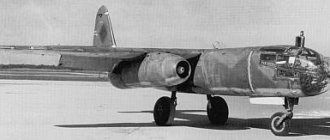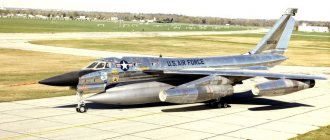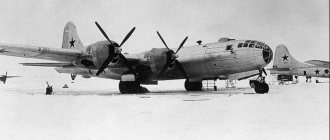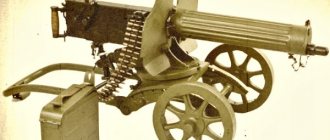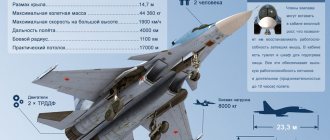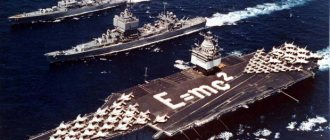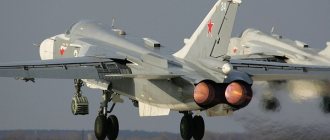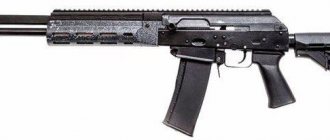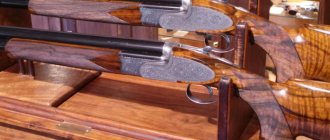The history of the development of the S-22 “Ilya Muromets” bomber aircraft
In 1911, the famous Russian aircraft designer I. I. Sikorsky designed the Russian Knight airplane. The aircraft initially had a twin-engine layout with engines with tractor propellers located on the lower wings of the biplane. Then an experiment was carried out with four, and two were installed with pulling screws, two with pushing screws. The engines were connected in pairs. Based on the results of the experiments, a four-engine aircraft went into production. The motors were located on the lower planes of the biplane box. In fact, this airplane was the harbinger of both “Ilya Muromets” and all heavy flying machines in general.
"Vityaz", alas, did not live long. In September 1913, an engine came off from a flying airplane and destroyed Vityaz. However, the impetus for the creation of Ilya Muromets took place.
In December of the same year, the first copy of the S-22 Ilya Muromets airplane took flight.
The development of the aircraft was carried out in St. Petersburg in the aviation department of the Russian-Baltic Carriage Plant. The design team also included the future “king of fighters” N. N. Polikarpov.
Using a biplane design, taking into account developments in the production of the Russian Knight, the aircraft turned out to be revolutionary for that time. The upper wing span was 32 m. Before this, no one in the world had made such airplanes.
At the same time, a passenger model of the aircraft was built. For the first time, an airplane had a separate cabin for passengers, which was heated by exhaust gases from the engines. Electric lighting was also installed. The passenger side offered its passengers a toilet and a bath. In the air there was access on the lower wing console. The roof of the fuselage was a walking platform.
Winter 1913-14 Passenger airplane tests were carried out. “Ilya Muromets” took off and successfully landed with 16 passengers and the dog Shkalik. The total weight of people and dogs is 1290 kg.
As the press of that time wrote: “Our talented pilot-designer I. I. Sikorsky set two new world records on February 12 on his Ilya Muromets - for the number of passengers and for carrying capacity. "Ilya Muromets" flew over the airfield and Pulkovo for 17 minutes and safely descended from a height of 200 m. The passengers - about ten military pilots, pilots and employees of the Russian-Baltic plant were delighted. Two commissioners of the flying club recorded this flight for dispatch to the bureau of the International Aeronautical Federation in Paris.”
Graphic restoration of the flight of the Ilya Muromets aircraft
In April 1914, the second ship left the factory workshops. The aircraft was equipped with new engines. The internal power was 140 hp. s., external - 125 l. With. On June 4, 1914, the designer conducted an away flight with 5 members of the State Duma. The aircraft climbed to an altitude of 2000 m. After this, the aircraft in the heavy bomber version was put into service.
By order of the naval department, the first copy was converted into a seaplane.
To demonstrate the aircraft's capabilities, Sikorsky proposed a test flight on the St. Petersburg-Kyiv route. Refueling was scheduled in Orsha. The team consisted of four people: captain I. Sikorsky, co-pilot - navigator Captain Christopher Prussis, co-pilot Lieutenant Georgy Lavrov and mechanic Vladimir Panasyuk. Almost a ton of gasoline, a quarter of a ton of oil and 150 kg of spare parts, materials and tools were loaded on board. In total, including the crew members, the airplane took on board a weight of 1610 kg.
The pilot changed every half hour. The flight went in the direction of Orsha. Around seven in the morning, the world's first in-flight breakfast took place.
The press called the results of the successful flight “impressive.” But the First World War was approaching.
The first period of the war quickly proved the fallacy of the tactics of scattered use of machines. And the chairman of the board of the Russian-Baltic plant, M.V. Shidlovsky, where the Muromets were produced, proposed merging them into one part. On December 23, 1914, a squadron of combat airships was formed. December 23 is established as a professional holiday for long-range aviation.
The composition of the squadron was determined to be 10 combat ships and 2 training ships. The squadron's first combat mission was recorded on February 15, 1915, when the squadron bombed a German military base. The takeoff was made from an airfield in Poland. The squadron's range of action was 500 km.
Salon "Ilya Muromets"
By the summer of 1916, the squadron already consisted of 30 S-22 Ilya Muromets bombers. Also included were escort fighters, reconnaissance aircraft and training aircraft.
With the beginning of the war, serial production of aircraft intensified. The “B” series became the most widespread - 30 pieces were produced. The crew included 4 people. Bomb load - 800 kg.
In 1915, production of the “G” series began. Several modifications were released in the series. The G-1 modification had 7 crew members; the G-2 had a shooting cabin to protect the rear hemisphere. In 1916, the G-3 modification went into production, and in 1917, the G-4 modification.
The G-2 series aircraft again set an altitude record of 5200 m.
During the First World War, deliveries to the active army amounted to 60 aircraft. The pilots flew more than 400 times to bomb and reconnaissance enemy positions. 65 tons of bombs were dropped on the enemy. 12 enemy fighters were destroyed in air battles.
The plane proved to be very durable. During the fighting, 2 vehicles were shot down by anti-aircraft fire, and 1 aircraft was shot down by fighter fire. In April 2016, during the German bombing of the home airfield, 4 aircraft were lost on the ground. More aircraft were lost due to technical reasons - 20 units.
After the revolution, the already very outdated aircraft was used for some time as a passenger and mail aircraft, however, by 1922 all the aircraft were already worn out. Due to exhaustion of resources, the aircraft were withdrawn from flight operations.
In 1979, a model of the S-22 “Ilya Muromets” aircraft was created for filming in the film “Wings to the Sky.” The plane could jog along the runway and taxiways. The model is currently in the Air Force Museum.
From wagons to aircraft
The official name of this company, and at first it really dealt exclusively with railway cars. But after the Russo-Japanese War, there were fewer orders, and the chairman of the board of the joint-stock company, Mikhail Vladimirovich Shidlovsky, decided to repurpose part of the capacity for assembling cars - first licensed, and then his own. Things got going, the plant management began to look for new promising directions. It was then that the idea arose to create his own aviation direction, where 23-year-old Sikorsky was invited in 1912.
Muromets_1
Igor Ivanovich Sikorsky
Photo: commons.wikimedia.org
Russian hero and flying boat: the largest aircraft in the world
Stories of the main air giants and a visual comparison of their characteristics and scales
The plant was initially located in Riga, but they decided to form the aviation department in St. Petersburg, on the basis of the Russo-Balt repair shops. General management was carried out by Shidlovsky. Once he invited a new young engineer to visit him, and a conversation ensued. Sikorsky spoke about his idea: to create a multi-engine aircraft with a completely enclosed cabin and fuselage, in which people could travel like in a bus. Moreover, Sikorsky was ready to do this at his own expense and in his free time. Shidlovsky liked the idea and enthusiasm of the young man, and he gave the go-ahead for the development of a prototype in the factory workshops.
Like Sikorsky, Shidlovsky was a graduate of the Naval Corps, only he graduated three decades earlier. Then there was service in the navy and even a circumnavigation of the world on the clipper ship Plastun. But combat service did not appeal to the young officer, and he entered the Alexander Military Law Academy. Then he served in the Ministry of Finance, became a member of the State Council of the Russian Empire, and an active state councilor. At the beginning of the century, Shidlovsky received an offer to head the board of Russo-Balt.
Muromets_2
Training 25-pound bomb. Third from right - Mikhail Vladimirovich Shidlovsky
Photo: commons.wikimedia.org
Sikorsky said in his memoirs that the idea of a multi-engine aircraft came to him after one incident that almost became tragic. Somehow, back in Kyiv, either a fly or a mosquito got into the carburetor jet of the plane he was piloting, the fuel stopped flowing and the engine went silent. Sikorsky miraculously managed to land the car. The shock of what happened made him think about the vicissitudes of fate and ways to make cars more reliable. Since the technology of the engines themselves was still imperfect, he considered duplicating the engines to be the only option that would guarantee to protect the crew from such unforeseen situations. Theoretical calculations showed that in this case the plane would be able to continue moving; all that remained was to figure out how to install two engines or even more on the body. No one in the world has done this before.
Description of design
The design of the Ilya Muromets is a four-engine biplane. The wings were connected by six connecting struts. The motors were located on the lower wing. To access the engines, a plywood walkway with wire railings was laid along the lower wings, giving access to any engine directly during flight. During a combat mission, the ability to repair the aircraft in flight more than once saved the lives of the aircraft and its pilots.
The length of the fuselage of the vehicle reached 19 meters, the area of the wings was 200 square meters. Aircraft speed is 100-130 km/h.
The chassis wheels were made with rubber cord shock absorption and covered with leather. Nowadays they would be called wide-profile.
Photo by Ilya Muromets
A special feature of the aircraft was its closed cockpit. Since the pilot could not see how far it was from the ground, the cockpit was equipped with instruments that were revolutionary for that time. In addition to the usual compass and four tacheometers, the cockpit contained two altimeters and two airspeed meters connected to a pitot tube (air pressure receiver). Also in the cockpit was a slip indicator - a curved glass tube with a ball inside.
View from the cockpit of Ilya Muromets
Pitch could be determined using the same device with marking angles for pitching and diving.
Recommendations
Notes
- One of Sikorsky's prized possessions was a personal gift from the Tsar - a gold watch with diamonds, which was later delivered by mail, also in recognition of his achievements with Ilya Muromets. Sikorsky kept the clock throughout his life.[14]
- Sikorsky used the French transliteration of the word "Ilya Muromets".[18]
Quotes
- Lumberjack, Harry. "Ilya Muromets". Airfix Magazine,
May 1985, p. 352. - Lake 2002, p. 31.
- Sikorsky 1938, p. 95.
- ^ a b
Sikorsky 1938, p. 96. - ^ a b c
Massenkov et al. 1994, p. 23. - Mackworth-Praed 1996, p. 202.
- Finn, K. (1987). Igor Sikorsky: Russian Years
. translated and adapted by Von Hardesty; Karl J. Bobrow and von Hardesty, eds. Washington, DC: Smithsonian Institution Press. p. 118. ISBN 0-87474-274-9. - "Guide to Passenger Airplanes." Airplane Guide
via
AircraftToday.com.
Access date: April 25, 2011. - Finn, K. (1987). Igor Sikorsky: Russian Years
. translated and adapted by Von Hardesty; Karl J. Bobrow and von Hardesty, eds. Washington, DC: Smithsonian Institution Press. paragraph 174. ISBN 0-87474-274-9. - Darcey et al. 1995, p. 38.
- Sikorsky 1938, p. 98.
- Finn, K. (1987). Igor Sikorsky: Russian Years
. translated and adapted by Von Hardesty; Karl J. Bobrow and von Hardesty, eds. Washington, DC: Smithsonian Institution Press. paragraph 40. ISBN 0-87474-274-9. - Sikorsky, 1938, p. 102–117.
- ^ a b c d f g gram
Sikorsky 2007, p. 10. - Finn, 1987, pp. 53–55.
- Windsock International,
Vol. 6, #3, May/June 1990, p. 16. - Loftin, Lawrence K. Jr. "Part I: The Propeller Age, Chapter 2: Design Study, 1914–18, Heavy Bombers." In Search of Performance: The Evolution of Modern Aircraft.
Washington, DC: NASA Science and Technology Information Office, 2004. Accessed April 25, 2011. - Sikorsky 1938, p. 119.
- Sergei I. Sikorsky with the Igor I. Sikorsky Historical Archive, Images of Aviation: The Sikorsky Legacy
, Arcadia Publishing, 2007, Charleston SC, Chicago IL, Portsmouth NH, San Francisco CA, 128 pp., ISBN 978-0-7385-4995-8 - Darcey et al. 1995, p. 33.
- Air Force // Soviet Military Encyclopedia (8 vols.) / Ed. N.V. Ogarkova. volume 2. M.: Military Publishing House, 1976. p.201-208
- ^ a b
Winchester 2004, p. 224. - Lienhard, John H. "Sikorsky Bomber. Episode No. 2371." Engines of Our Ingenuity,
2008. Date of access: April 25, 2011. - Palmer, Scott W. "The Russian Origins of Strategic Air Operations." The Great War and Revolution in Russia: Western Illinois University,
February 15, 2011. Accessed: April 25, 2011. - "Knights of the Air: Sikorsky Superbomber." Diesel Punky
October 7, 2010 Accessed April 25, 2011 - "Early Soviet Civil Aviation". Airlines and airliners.
Access date: April 25, 2011. - ^ a b c
Khajrulin 2022, p. 21–45 - "Central Air Force Museum". Monino. Retrieved October 28, 2014.
- Angelucci 1983, p. 67.
Bibliography
- Angelucci, Enzo. Rand McNally's Encyclopedia of Military Aircraft, 1914–1980.
. San Diego, CA: Military Press, 1983. ISBN 0-517-41021-4. - Cochrane, Dorothy and Von Hardesty. Aviation career of Igor Sikorsky.
Seattle, WA: University of Washington Press, 1989. ISBN 978-0-295-96916-9. - Darcy, Alan, Thomas Kulikov, and Victor Durkotz. Russian Imperial Aviation: famous pilots and aircraft of the First World War.
Mountain View, CA: Flying Machine Press, 1995. ISBN 978-1-891268-07-6. - Delir, Frank J. Igor Sikorsky: Three Careers in Aviation
(Air and Space Series, No. 24). New York: Bantam, 1992. ISBN 978-0-553-29701-0 - Durkota, Alan E., T. Darcy, and V. Kulikov. Russian Imperial Aviation: Famous Pilots and Aircraft of the First World War
. Boulder, CO: Flying Machines Press, 1995. ISBN 0-9637110-2-4. - Finn, K. Igor Sikorsky: Russian years.
Washington, DC: Smithsonian Books, 1987. ISBN 0-87474-274-9. - Finn, K. Russian air heroes of I. Sikorsky (Russian air warriors: I. Sikorsky) (Russian).
M.: AST, Harvest, 2005. ISBN 985-13-2878-2 - Lake, John. The Great Book of Bombers: The World's Most Important Bombers from World War I to the Present.
St. Paul, MN: MBI Publishing, 2002. ISBN 0-7603-1347-4. - Mackworth-Prad, Ben. Aviation: Pioneer years.
London: Studio Editions, 1996. ISBN 1-85170-349-7. - Massenkov, Vladamir I., Boris Urinovsky and Vadim I. Suvorov. Russia in ICAO for the 50th anniversary of ICAO
. Moscow: 1994. Without ISBN. - Miller, Russell. Soviet aviation at war.
Alexandria, VA: Time-Life Books, 1983. ISBN 0-8094-3371-0. - Pember, Harry. Sikorsky aircraft: from vision to reality and beyond.
Stratford, CT: Sikorsky Aircraft Corporation, 1999. No ISBN. - Rustam-Bek-Tageev, LCol Boris. Air Russia: The Romance of the Giant Airplane.
Austin, TX: Alexander Palace Time Machine (Bob Atchison), 2011, Online reprint of the original 1917 edition. - Sikorsky, Igor. History of Winged-S: autobiography of Igor Sikorsky.
New York: Dodd, Mead & Company, 1938. No ISBN. - Sikorsky, Sergei I. Sikorsky's legacy
(Images of aviation). Charleston, SC: Acadia Publishing, 2007. ISBN 978-0-7385-4995-8. - Taylor, John W.R. Jane's World War I Fighting Plane
. London: Studio Editions, reprint 2001. ISBN 1-85170-347-0. - Winchester, Jim. "Sikorsky Ilya Muromets." Biplanes, Triplanes and Seaplanes (Aviation Fact File)
. London: Grange Books plc, 2004. ISBN 1-84013-641-3. - Lumberjack, Harry. Sikorsky Ilya Muromets Type Vekh,
(Windsock Data File, Special No. 3 - World War I Aviation Classics, Volume 3). Berkhamsted, Herts, UK: Albatros Productions Limited, 2000. ISBN 978-1-902207-13-1. - Khadzhrulin M.A. (2018). The legendary "Ilya Muromets".
The first heavy bomber (in Russian). Moscow: Yauza. ISBN 978-5-04-091056-4.
Performance characteristics
The characteristics of the G-3 series aircraft are given in the table:
| Span x length x height, m | 30.87 x 17.10 x 4.00 |
| Engines | 2 x Renault (220 hp) and 2 x RVZ-6 (150 hp) |
| Wing area, m2 | 159 |
| Weight: empty, kg take-off, kg | 3800 5400 |
| Maximum speed, km/h | 135 |
| Ceiling, m | 3400 |
| Flight duration, hour | 4, 5 |
| Weapons: small arms bomb, kg | 5-8 turret and pivot machine guns of different systems 500 |
| Crew, people | 6 |
"Professions" of a hero
The IL-76 has proven to be an effective platform for various special types of aircraft, including tanker aircraft, air hospitals and flying laboratories. As TASS was told by the United Aircraft Corporation (UAC as part of the Rostec state corporation), 22 modifications . Among them:
— Il-76M / Il-76MD / Il-76MD-M. These aircraft have significantly increased maximum take-off weight and load. Currently, the basic Il-76MD aircraft are being upgraded to the Il-76MD-M level with the installation of modernized lighting, airborne transport and household equipment, as well as updated defense and communications equipment.
Il-76MD-M © Armen Gasparyan/PJSC "Il"
— IL-76MF. It differs from the base aircraft in its increased carrying capacity. The aircraft received PS-90A-76 engines and modernized flight and navigation equipment; its fuselage was lengthened by 6.6 m. In 2011, two Il-76MF aircraft were delivered to Jordan and specialized in cargo transportation in the Middle East, Africa and Asia.
— Il-76T / Il-76TD / Il-76TD-90VD. Civil modifications, the most modern - Il-76TD-90VD - is equipped with PS-90A-76 engines. It currently operates flights to Antarctica to supply polar stations.
— Il-78 / Il-78M / Il-78M-2. Refueling aircraft are equipped with additional fuel tanks and standardized outboard refueling units.
— Il-78M-90A. A tanker aircraft based on the Il-76MD-90A military transport aircraft.
— IL-76LL. An aircraft designed to test advanced aircraft engines. The standard left inboard engine has been removed and is replaced by an engine intended for testing on a non-standard, reinforced pylon.
— IL-76MDK. A modification of the Il-76MD aircraft, intended for training cosmonauts in conditions of short-term artificial weightlessness.
Cosmonaut training inside the Il-76MDK aircraft © Armen Gasparyan/Il PJSC
Advantages and disadvantages
The Ilya Muromets was the leading aircraft in 1914. A huge bomb load for those times, a long range, powerful defensive weapons and resistance to damage in battle - these are the advantages of the bomber.
Unfortunately, the aircraft has many shortcomings. The first and most important is the variety of engines. The production that had begun with German engines ceased at the beginning of the war. Germany did not supply engines. Attempts to install French and English engines led to a reduction in the bomb load and other flight characteristics of the aircraft. Frequent technical breakdowns accompanied this model. Because of this, many sides were damaged during landing or were laid up due to lack of repairs. Therefore, by the end of the war, the aircraft were used mainly as a huge reconnaissance aircraft. The plane could not pull a bomb load on low-power engines.
Main weapons
At the beginning of the war, plans were to install a cannon on the aircraft that could be used against Zeppelins. Experiments were carried out, after which the gun was abandoned. However, the plane needed protection. If at first the crew’s personal weapons were enough, then with the progress of enemy fighter aircraft they began to install machine guns on the planes. Because of this, the number of crew members has increased. The specialty of an air gunner appeared.
As for the main weapons - bombs, the aircraft could take up to 800 kg of bombs. But the actual mass of bomb weapons was lower; the bomber carried no more than 500 kg of bombs on board.
Historical value of the aircraft
At the beginning of its service, in 1914, the aircraft was an advanced airship, which had no equal. He set a strong vector of development for both bomber and passenger aircraft manufacturing.
The airplane had many opportunities for further modernization, but the collapse of the Russian Empire prevented its development. Nevertheless, the practice of using long-range bomber aircraft was developed for the first time.
For the first time, a long-distance flight was made, which gave rise to civil passenger aviation. Therefore, we can say that it was a very good plane that happened to be born at an unlucky time.
Tanker aircraft
Speaking about the Il-76MD-90A, it is necessary to emphasize that the aircraft became the basis for the newest Il-78M-90A tanker, the first flight of which took place on January 25, 2022.
In the future, this particular vehicle will become the main platform intended for in-flight refueling of Russian long-range, front-line and special aviation aircraft. The Il-78M-90A is a convertible refueling aircraft - if necessary, it can be used as a regular military transport aircraft, which meets modern world requirements for this class of equipment.
Il-78M-90A © Armen Gasparyan/PJSC "Il"
The IL-78M-90A tanker version is equipped with the latest UPAZ (universal suspended refueling units) and provides increased fuel delivery speed. It also features an electronic control system for easy operation. Domestic tankers are also in demand on the world market. According to FlightGlobal, the Il-78 ranks sixth in the world's top 10 aircraft designed for in-flight refueling: 35 78s are in operation worldwide, accounting for 4% of the global fleet of refueling aircraft.
“Over the entire history of the Il-76 program, about 1 thousand aircraft of this type were produced and delivered to customers. This is the best proof of its reliability, ease of use, and versatility,” adds First Deputy General Director of UAC Yarkova.
